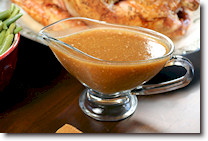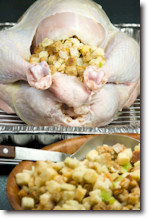 I first posted this on an online forum in 1985; since then it has been posted here there and everywhere; on one occasion, I even
received it in my email as a good recipe to try, from someone who didn't realize it was mine in the first place. It really needed a
permanent home.
I first posted this on an online forum in 1985; since then it has been posted here there and everywhere; on one occasion, I even
received it in my email as a good recipe to try, from someone who didn't realize it was mine in the first place. It really needed a
permanent home.
If you want to start out old school - by which I mean the good old fashioned way to roast a turkey, this is the way to go. Trust me - no matter how inexperienced a cook you are, even you can't mess this up. These step by step instructions are pretty much can't miss.
I figure if there's even one person who is stuck with having to roast a turkey, and whose entire experience with cooking consists of pressing "start" on the microwave, then this recipe serves a higher purpose. (It also serves between six to 20 people, depending on the size of your turkey)
I've heard a lot of good things about brined turkeys, but I
confess I haven't tried one yet. I like this recipe so much, I haven't wanted
to veer off it, but if I ever do, I'll post about it here.
Turkey Brining Information & Supplies
Please read through the whole thing before you start, so you have an idea of what all is required as far as time and materials!!!
TO BEGIN WITH:
If frozen, thaw your turkey 2-3 days in refrigerator (or on the back porch, if it's cold out and the dog is tied up.) Do NOT thaw it on the counter - it will become a bacteria factory.
IF turkey is still partially frozen, put in sink under COLD running water (probably for at least an hour). Check and flip frequently until thawed; then drain thoroughly. And keep a close eye on it.
DAY BEFORE THANKSGIVING:
Remove giblets (those gross looking things wrapped in paper; found inside the turkey, generally) trim any fat and simmer the giblets in good sized saucepan with chopped celery tops from an entire bunch of celery, one medium or large onion (chopped), 1/2 bayleaf, 3-4 garlic cloves (minced). Simmer at least three hours. Cool the liquid, strain it, saving out the giblets. (You can trash the veggies - you won't need them) Refrigerate both the liquid and the giblets overnight. On the next day (Thanksgiving), remove any congealed fat on top of the liquid, and discard it. Chop giblets and set aside. All of this except the fat will go into gravy).
THANKSGIVING DAY:
Get up EARLY!
 Rinse bird thoroughly by flushing cold water through the breast cavity, and pat dry with a paper towel. You *may*
want to salt the cavity, that's pretty much up to individual taste preferences.
Rinse bird thoroughly by flushing cold water through the breast cavity, and pat dry with a paper towel. You *may*
want to salt the cavity, that's pretty much up to individual taste preferences.
Stuff bird in stomach and breast cavities (not too tightly; they've been known to explode in the oven if overstuffed). Close with turkey pins,
string, glue, duct tape... whatever you got (ork ork). Rub bottom (of bird, that is) with soft butter. Careful now, this sucker gets slippery! Place breast (top of turkey) up on rack in a large turkey roaster
. Cover bird with cheesecloth or other clean, thin, white cloth, tucking in to cling to the bird all the way down. (Believe it or not, when I was a kid, my mother used a clean cloth diaper. Emphasis on CLEAN) It should be 2-3 layers thick if you're using actual cheesecloth, 1 layer if any other cloth. Brush or pour about 1/4 to 1/3 cup of melted butter on bird through the
cloth.
Roast uncovered (except for cloth) @ 300 degrees - and allow 25 minutes per pound. (Or 20 minutes per pound @ 325 degrees, if you must hurry it)
Baste with juices from pan every 30 minutes; augment with butter and/or chicken broth if you need to. Do not remove cloth - this is what browns the turkey perfectly and keeps it moist; never too brown, nor too dry.
You can use a meat thermometer
if desired (although it's not strictly necessary if you trust the temperature in your oven) Stick the meat thermometer in the fleshiest part of the leg - make sure you DON'T let the thermometer touch the bone. The turkey is done when it reaches 180-185 degrees or so.
REMOVE CLOTH (this is important - cheesecloth is not at ALL good Thanksgiving fare, being rather tough and stringy)
Remove to a big platter or pan and plan to let cooked bird 'set'; outside the oven for at least 20 minutes before carving. (Don't worry, it won't be too cold to eat) This is the time to remove the stuffing. Also would be helpful to put any feline type observers in the basement, as they will likely be climbing up your legs at this point. We used to have a Siamese who would sit in front of the oven for HOURS just watching the bird brown through the glass.
GRAVY TIME
Separate all possible fat from pan drippings. Save 3-4 tablespoons of fat. Leave dark brown drippings in pan. Pour 3-4 cups of giblet broth (what you made yesterday) into pan drippings. Heat to simmer on top of stove, stir and scrape well.
Mix 3 tablespoons of fat, and 3 tablespoons of flour in large frying pan, bring to simmer, stirring constantly; cook 2-3 minutes until thickened.p>
Gradually add broth/drippings liquid, stirring constantly. This will get VERY THICK at first, but keep adding & stirring to desired thickness (when broth/drippings are gone, use rest of giblet broth as needed)
Check to see if it needs additional salt or pepper (TASTE it first!); add the chopped giblets from yesterday and simmer on low about 5 minutes. Keep hot until served. If it seems a little too pale to be appetizing, there's this wonderful stuff called Kitchen Bouquet
, and a couple of drops will turn it a rich golden brown (without diluting the taste).
THE STUFFING
Here is what you'll need:
►3 cups diced onion
►3 cups diced celery
►1 and 1/2 cups melted butter
►15 cups VERY DRY (stale) bread cubes; plain, white. **
►1 and 1/2 teaspoon salt
►3/4 teaspoon pepper
►3 tablespoons Rubbed Sage
►6 bouillon cubes mixed with 6 cups of
water OR
►6 cups of chicken broth
NOTES:
I cut up bread 2-3 days ahead of time and let it stand - tossing now
and then. The dryer the bread, the better the stuffing.
** Pepperidge Farms and other companies have been packaging seasoned
"stuffing bread cubes"; though it originally offended my
sensibilities to purchase prepared bread cubes, I have tried them
and found them to be very good. You might want to go that route
rather than drying your own. In which case, 1 to 1 1/2 large bag
will do the trick.
If you use bouillon cubes - DO NOT ADD ANY SALT!
Saute onion, celery, seasonings in butter until tender, pour over bread cubes and toss. Add broth/bouillon and toss lightly but thoroughly. CHILL BEFORE STUFFING BIRD.
Bake any excess stuff separately, adding broth and/or pan drippings
(if you STILL have any left over) to add flavor.
Last, but never least - persuade some other poor
slob to carve the turkey
Good luck and I hope it works out for you...
